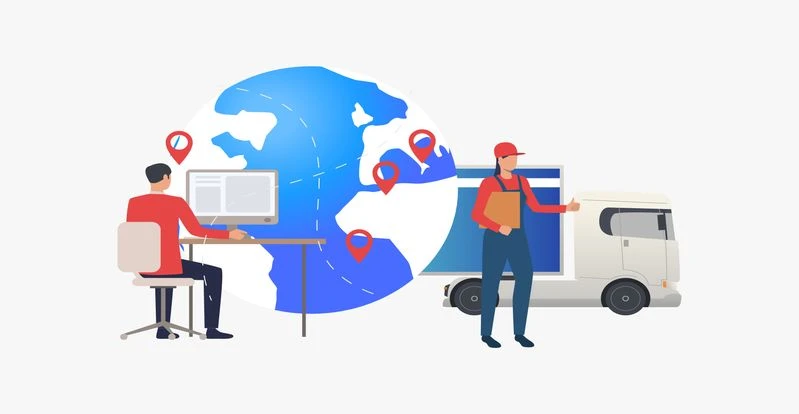Digital Transformation: Impact and Importance for Logistics Business

Many external and internal stimuli force logistics businesses to consider digital transformation (DT). We can regard industry 4.0 and the COVID-19 pandemic as external stimuli. Industry 4.0 has set new standards and demands for the supply chain industry as there is always a need for any industry to change and evolve.
Whereas COVID-19 forces businesses to act quickly and be flexible in this changing and unexpected world. On the organizational or internal level, supply chain executives have also experienced the necessity to grow and remain competitive.
According to the 2022 KPMG report on the future of the logistics industry and supply chain, today’s market leaders build digitally-enabled and predictive supply chain networks with the customer at the center. And those companies that are leaders today can become true digital innovators of the future supply chain.
Digital technologies are now the best way to cope with the growing demands of the modern world. Most importantly, digitalization and, as a consequence, automation allows logistics businesses to build a robust working environment and become more confident in their future. However, we should differentiate between these two notions of digital transformation and digitalization. Let’s discuss the difference in the first section of this article.
Digital Transformation vs Digitalization
Logistics digital transformation is a disruptive process that takes place on an enterprise-wide level and requires a feasible DT roadmap. It means defining digital as a core value on each level of the supply chain management: strategic, tactical, and operational.
Digitalization, in turn, is one of the stages toward DT, and it means the adoption of certain technologies by a particular department. The importance of digitalization can’t be underestimated, as, without particular digital technologies, DT makes no sense.
For instance, digitalization would be an implementation of a warehouse management system (WMS) that is meant to automate and accelerate warehousing. DT, in turn, would mean a whole range of such small digitization initiatives along with staff training. Let’s discuss in the next section what can push logistics companies to dive into DT.

4 reasons why logistics companies need digital transformation
The decision to involve in logistics transformation seems reasonable by itself. But each logistic software development company is a unique organization, and it’s critical to come up with an individual list of reasons, advantages, and disadvantages of the DT undertaking.
Let’s explore what common reasons a logistics company can have to embark on a DT journey.
- Stay competitive:
To stay relevant in the logistics market for long is critical for any business. And if some companies are actively adopting digital solutions, other logistics businesses are lagging behind and don’t know where to start to win the market. A well-thought-out DT roadmap can help digital laggards incrementally evolve and grow to become digital leaders eventually. - Enhance services:
With a clear DT strategy, logistics companies can find lots of opportunities to improve their service delivery as well as add more services. For example, thanks to digitalization, a transportation logistics company can offer clients online container loading options for optimized and cost-efficient container space usage. And this way, the company can optimize the whole range of supply chain transport services. - Streamline logistics operations:
Often, DT leads to automation and partial elimination of routine manual work. Thus, it’s getting easier to deliver any services quickly and efficiently. For instance, digital transportation services can enable optimized route planning for inbound and outbound logistics to reduce movements in the warehouse. Thus, warehouse operators can also manage to place and pick up goods quickly. - Improve customer experience:
A digital logistics company can definitely better satisfy customer needs thanks to the proper data management across the whole company. If different departments easily communicate with each other and can quickly synchronize, the service delivery is quick and hassle-free. Data synchronization is largely enabled by digital technologies that eliminate obstacles on the way to a complete supply chain visibility. Plus, digital solutions help to personalize customer experience as there are many ways to study customer behavior, like advanced data analytics capabilities.
Each particular logistics company can also have its own reasons in favor of DT to prolong this list. But once logistics executives opt for DT, they should be prepared for lots of disruptions to business operations that this decision involves.
The effect of digital logistics on business processes
With the rapid digital disruption, logistics business operations have started changing, and this process is ongoing.
Many new players have entered the market since digitalization makes evolving and winning customers easier. Thus, competition in the supply chain market has accelerated, giving customers the ground to raise their expectations.
Business operations have started changing on all three levels of the supply chain management:
- Strategic – Goal-setting processes have shifted towards a more customer-centric direction and involved the need to cut capital and operational expenses thanks to digital technologies.
- Tactical – On this level, the center managers altered their means of checking logistics service performance. They’ve shifted towards data analytics, visualization, and dashboarding tools for a convenient and transparent overview of business processes.
- Operational – Daily logistics operations have also undergone the most fundamental changes, from automated inventory management to real-time tracking of shipments.
Technologies continue disrupting and challenging logistics business operations to meet the demands of the volatile supply chain market. However, digital disruption isn’t only about technologies, as some technologies may become obsolete with time.
Digital disruption also means a shift towards a digital mindset and the readiness of the logistics company to always stay digitally flexible and modify its services whenever necessary.
Ways digital transformation is changing logistics and supply chains
The logistics market is multi-faceted, but even if some companies begin with their DT journeys, they unintentionally set the pace for the whole market. They may even speed up the DT initiatives of other companies. Thus, DT examples of a few logistics companies impact the whole supply chain domain.
DT is augmenting the logistics and supply chain world in multiple ways. Below we discuss a few of them relying on the BDO’s research.
- Interconnected supply chain:
Digital technologies allow for the creation of an uninterrupted and seamless supply chain flow. For instance, IoT sensors installed in the warehouse and on the trucks keep all supply chain parties informed on the real-time delivery status. - Customer-centric supply chain management:
The frequency of goods replenishment and stock planning strategies depends on the customers’ needs and demand. Digital options for efficient demand projecting as well as management are necessary for the present logistics business. Machine learning algorithms and advanced analytics tools are helpful in proper demand forecasting. - Customer expectations are quickly increasing:
A growing variety of digital supply chain services makes customers more demanding and less tolerant of even the smallest issues like late delivery or multiple-step return procedure. And supply chain organizations have nothing left but rather keep up with the expectations of their B2C and B2B clients. Digitalization and automation tools, in this case, give a genuine helping hand as they take away the pressure from the employees who perform many logistics operations manually. - Enhanced communication environment:
Digital technologies enable productive and simplified communication between the supply chain workforce as well as with the clients. For instance, AI-powered chatbots can substitute people in providing customer support and handle repetitive issues. RPA tools can automate many bureaucratic processes unburdening customers and supply chain providers. - Higher rate of cyber risks:
Cybersecurity measures should be of utmost importance as digitalization can make your company vulnerable to multiple internal and external cyber threats. If a DT journey isn’t properly reasoned and thought out, there are many chances to cooperate with untrustworthy third-party digital service providers. The latter can put logistics company software systems at risk. Thus, a DT can’t happen in a rush but gradually and with a feasible DT roadmap.
Begin with DT or not is, of course, up to every logistics company. Some logistics executives may fear that digitalization will completely reshape their long-known brand. Instead of satisfying clients, it will only repel them.
However, every business undertaking is a risk, and there is no more time to hold on to legacy ways of work that keep logistics operations stable but don’t encourage growth. One more argument in favor of starting with DT now is that this journey is long and gradual and may take years. So the earlier you start, the earlier you’ll reach the desired destination, enjoying all the promised perks of your DT initiative.


